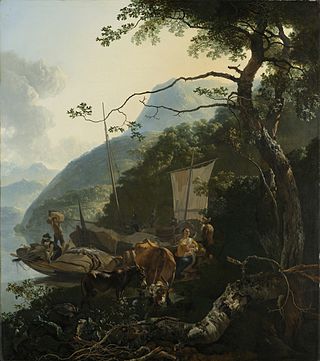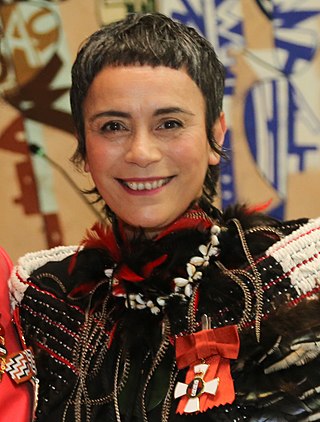Elizabeth Ann Dewar Churcher was an Australian arts administrator, best known as director of the National Gallery of Australia from 1990 to 1997. She was also a painter in her own right earlier in her life.
Davida Frances Allen is an Australian painter, filmmaker and writer.

The Art Gallery of South Australia (AGSA), established as the National Gallery of South Australia in 1881, is located in Adelaide. It is the most significant visual arts museum in the Australian state of South Australia. It has a collection of almost 45,000 works of art, making it the second largest state art collection in Australia. As part of North Terrace cultural precinct, the gallery is flanked by the South Australian Museum to the west and the University of Adelaide to the east.

Sam Leach is an Australian contemporary artist. He was born in Adelaide, South Australia. Leach worked for many years in the Australian Tax Office after completion of a degree in Economics. He also completed a Diploma of Art, Bachelor of Fine Art degree and a Master of Fine Art degree at RMIT in Melbourne, Victoria. Leach currently resides in Melbourne. Leach's work has been exhibited in several museum shows including "Optimism" at the Queensland Art Gallery and "Neo Goth" at the University of Queensland Art Museum in 2008, in 2009 "the Shilo Project" at the Ian Potter Museum of Art and "Horror Come Darkness" at the Macquarie University Art Gallery and "Still" at Hawkesbury Regional Gallery in 2010. His work is held in public collections of regional galleries of Geelong, Gold Coast, Coffs Harbour, Newcastle and Gippsland and the collections of La Trobe University and the University of Queensland.

Makinti Napanangka was a Pintupi-speaking Indigenous Australian artist from Australia's Western Desert region. She was referred to posthumously as Kumentje. The term Kumentje was used instead of her personal name as it is customary among many indigenous communities not to refer to deceased people by their original given names for some time after their deaths. She lived in the communities of Haasts Bluff, Papunya, and later at Kintore, about 50 kilometres (31 mi) north-east of the Lake MacDonald region where she was born, on the border of the Northern Territory and Western Australia.
Bindi Cole Chocka is an Australian contemporary new media artist, photographer, writer and curator of Wadawurrung heritage.
Glenn Barkley is an Australian artist, independent curator and writer based in Sydney, Australia. As an artist he is represented by Sullivan+Strumpf, Sydney, Niagara Galleries, Melbourne and Mindy Solomon Gallery, Miami and his works are held in institutional collections such as the National Gallery of Australia, Canberra and Artbank.
Emma Camden is an English-New Zealand glass artist.

Lisa Marie Reihana is a New Zealand artist. Her video work, In Pursuit of Venus [Infected] (2015), which examines early encounters between Polynesians and European explorers, was featured at the 2017 Venice Biennale.
Hiromi Tango is a contemporary artist working predominantly with textiles in installation and performance art. Tango was born in 1976 on the Japanese island of Shikoku. Tango graduated from a Bachelor of Arts at the Japan Women's University in Tokyo, Japan. The artist lives and works in Tweed Heads, Australia with her partner artist Craig Walsh.
Aida Tomescu is an Australian contemporary artist who is known for her abstract paintings, collages, drawings and prints. Tomescu is a winner of the Dobell Prize for Drawing, the Wynne Prize for Landscape and the Sir John Sulman Prize, by the Art Gallery of New South Wales.
Alex Seton is an Australian artist, known for his contemporary use of marble carving. He also works in sculpture, photography, video and installation.

Fiona Connor is a visual artist from New Zealand, currently based in Los Angeles.
Jennifer Herd is an Australian Indigenous artist with family ties to the Mbar-barrum people of North Queensland. She is a founding member of the ProppaNOW artist collective, and taught at the Queensland College of Art in Brisbane, where she convened both the Bachelor of Fine Art and Contemporary Australian Indigenous Art. In 2003 she won the Queensland College of Art Graduate Students prize, the Theiss Art Prize, for her Masters of Visual Arts.
Nell is an Australian artist working across performance, installation, video, painting and sculpture. In 2013, she won the University of Queensland Self-Portrait Award. In 2017, she was inducted into the Maitland City Hall of Fame in the category of The Arts.

Julia deVille is a New Zealand-born artist, jeweller and taxidermist, who only uses subjects in her taxidermy that have died of natural causes. She lives and works in Australia.
Carol McGregor is an Indigenous Australian artist of Wathaurung (Victoria) and Scottish descent, internationally known for her multi media installation pieces bringing together ephemeral natural fibres, metal, and paper. She is also deeply engaged in the creation of and cultural reconnection to possum skin cloaks, a traditional form of dress and important biographical cultural item.

Lindy Lee is an Australian painter and sculptor of Chinese heritage, whose work blends the cultures of Australia and her ancestral China and explores her Buddhist faith. She has exhibited widely, and is particularly known for her large works of public art, such as several iterations of The Life of Stars at various locations in China and on the forecourt of the Art Gallery of South Australia, and The Garden of Cloud and Stone in Sydney's Chinatown district.
Angela Cavalieri is an Australian printmaker, whose work recreates text and narratives in visual form and was included in the Venice Biennale, 2011.

Hoda Afshar is an Iranian documentary photographer who is based in Melbourne. She is known for her 2018 prize-winning portrait of Kurdish-Iranian refugee Behrouz Boochani, who suffered a long imprisonment in the Manus Island detention centre run by the Australian government. Her work has been featured in many exhibitions and is held in many permanent collections across Australia.








